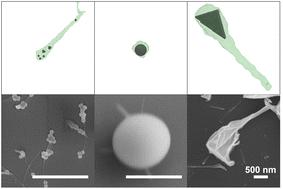Our official English website, www.x-mol.net, welcomes your
feedback! (Note: you will need to create a separate account there.)
Controlling morphology in electrosprayed methylcellulose nanowires via nanoparticle addition: coarse-grained modeling and experiments
Nanoscale ( IF 5.8 ) Pub Date : 2022-11-15 , DOI: 10.1039/d2nr04177d Jonathan M Blisko 1 , Michael J Grzenda 2 , Rachel M Vladimirsky 3 , Christopher E Shuck 4 , Jonathan P Singer 2, 3 , Xin Yong 1
Nanoscale ( IF 5.8 ) Pub Date : 2022-11-15 , DOI: 10.1039/d2nr04177d Jonathan M Blisko 1 , Michael J Grzenda 2 , Rachel M Vladimirsky 3 , Christopher E Shuck 4 , Jonathan P Singer 2, 3 , Xin Yong 1
Affiliation

|
Electrospray deposition (ESD) has shown great promise for manufacturing micro- and nanostructured coatings at scale on versatile substrates with complex geometries. ESD exhibits a broad spectrum of morphologies depending upon the properties of spray fluids. Among them are nanowire forests or foams obtained via the in-air gelation of electrospray droplets formed from methylcellulose (MC) solutions. In this study, we explored MC ESD loaded with nanoparticles of various shapes and uncovered the effects of particle fillers on morphology evolution using coarse-grained simulations and physical experiments. Utilizing electrostatic dissipative particle dynamics, we modeled the electrohydrodynamic deformation of particle-laden MC droplets undergoing in-flight evaporation. The simulations quantitatively predict the suppression of droplet deformation as the size or concentration of spherical nanoparticles increases. While small particles can be readily encapsulated into the nanowire body, large particles can arrest nanowire formation. The model was extended to nanoparticles with complex topologies, showing MC nanowires emerging from particle edges and vertices due to curvature-enhanced electric stress. In all cases, strong agreements were found between simulation and experimental results. These results demonstrate the efficacy of the coarse-grained model in predicting the morphology evolution of electrosprayed droplets and lay the groundwork for employing MC nanowires for developing nanostructured composites.
中文翻译:

通过纳米颗粒添加控制电喷雾甲基纤维素纳米线的形态:粗粒度建模和实验
电喷雾沉积 (ESD) 已显示出在具有复杂几何形状的多功能基材上大规模制造微米和纳米结构涂层的巨大前景。ESD 表现出广泛的形态,具体取决于喷雾液的特性。其中包括通过纳米线森林或泡沫获得的由甲基纤维素 (MC) 溶液形成的电喷雾液滴在空气中的凝胶化。在这项研究中,我们探索了载有各种形状纳米粒子的 MC ESD,并使用粗粒度模拟和物理实验揭示了粒子填料对形貌演化的影响。利用静电耗散粒子动力学,我们模拟了载有粒子的 MC 液滴在飞行中蒸发的电流体动力学变形。随着球形纳米颗粒的尺寸或浓度的增加,模拟定量地预测了液滴变形的抑制。虽然小颗粒可以很容易地封装到纳米线体中,但大颗粒可以阻止纳米线的形成。该模型扩展到具有复杂拓扑结构的纳米粒子,显示由于曲率增强的电应力从粒子边缘和顶点出现的 MC 纳米线。在所有情况下,模拟和实验结果之间都存在很强的一致性。这些结果证明了粗粒度模型在预测电喷雾液滴形态演变方面的功效,并为使用 MC 纳米线开发纳米结构复合材料奠定了基础。
更新日期:2022-11-15
中文翻译:

通过纳米颗粒添加控制电喷雾甲基纤维素纳米线的形态:粗粒度建模和实验
电喷雾沉积 (ESD) 已显示出在具有复杂几何形状的多功能基材上大规模制造微米和纳米结构涂层的巨大前景。ESD 表现出广泛的形态,具体取决于喷雾液的特性。其中包括通过纳米线森林或泡沫获得的由甲基纤维素 (MC) 溶液形成的电喷雾液滴在空气中的凝胶化。在这项研究中,我们探索了载有各种形状纳米粒子的 MC ESD,并使用粗粒度模拟和物理实验揭示了粒子填料对形貌演化的影响。利用静电耗散粒子动力学,我们模拟了载有粒子的 MC 液滴在飞行中蒸发的电流体动力学变形。随着球形纳米颗粒的尺寸或浓度的增加,模拟定量地预测了液滴变形的抑制。虽然小颗粒可以很容易地封装到纳米线体中,但大颗粒可以阻止纳米线的形成。该模型扩展到具有复杂拓扑结构的纳米粒子,显示由于曲率增强的电应力从粒子边缘和顶点出现的 MC 纳米线。在所有情况下,模拟和实验结果之间都存在很强的一致性。这些结果证明了粗粒度模型在预测电喷雾液滴形态演变方面的功效,并为使用 MC 纳米线开发纳米结构复合材料奠定了基础。











































 京公网安备 11010802027423号
京公网安备 11010802027423号